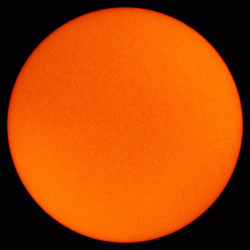
So what's up with our Sun? Is it going through a depression? It seems as if our closest star is experiencing a surprisingly uneventful couple of years. Solar minimum has supposedly passed and we should be seeing a lot more magnetic activity, and we certainly should be observing lots more sunspots. Space weather forecasts have been putting Solar Cycle 24 as a historically active cycle… but so far, nothing. So what's the problem? Is it a ticking bomb, waiting to shock us with a huge jump in solar activity, flares and CMEs over a few months? Or could this lack of activity a prelude to a very boring few years, possibly leading the Earth toward another Ice Age?
It's funny. Just as we begin to get worried that the next solar maximum is going to unleash all sorts of havoc on Earth (i.e. NASA's 2006 solar storm warning), scientists begin to get concerned as to whether there is going to be a solar maximum at all. In a conference last week at Montana State University, solar physicists discussed the possibility that the Sun could be facing a long period of calm, leading to the concern that there could be another Maunder Minimum. The Maunder Minimum (named after the late 19th Century solar astronomer Edward W. Maunder, who discovered the phenomenon) was a 17th Century, 30-year period when very few sunspots were observed on the disk of the Sun. It is thought by many scientists that this period contributed to what became known as the "Little Ice Age" here on Earth. As the Sun provides Earth with all its energy, during extended periods when the solar output is lower than average, it seems possible a lack of sunspots on the Sun (i.e. low activity) may be linked with periods of cold down here.
"It continues to be dead. That's a small concern, a very small concern." - Saku Tsuneta, National Astronomical Observatory of Japan and program manager for the Hinode solar mission.
However, solar physicists are not too worried about this possibility, after all, it's only been two years since solar minimum. Although activity has been low for the beginning of Cycle 24, sunspots have not been non-existent. In January of this year, a newborn spot was observed, as expected, in high latitude regions. More spots were seen in April. In March, sunspots from the previous solar cycle even made an appearance, putting on an unexpected show of flares and coronal mass ejections (CMEs).
As pointed out by David Hathaway, a solar physicist at NASA's Marshall Space Flight Center, the fact that sunspots have already been observed in this new cycle means that it is highly unlikely we face anything as extreme as another Maunder Minimum. Hathaway says there is nothing unusual about having a relatively understated solar cycle after several particularly active cycles. Solar Cycle 23 was a very active period for the Sun with a greater than average number of sunspots observed on the solar surface.
It appears there are two different predictions for the activity level of the next solar cycle. On the one hand we have scientists that think this cycle might be below average, and on the other hand we have scientists who believe the next cycle will be the biggest yet. We certainly have a long way to go before we can begin making any accurate solar forecasts…



No comments:
Post a Comment